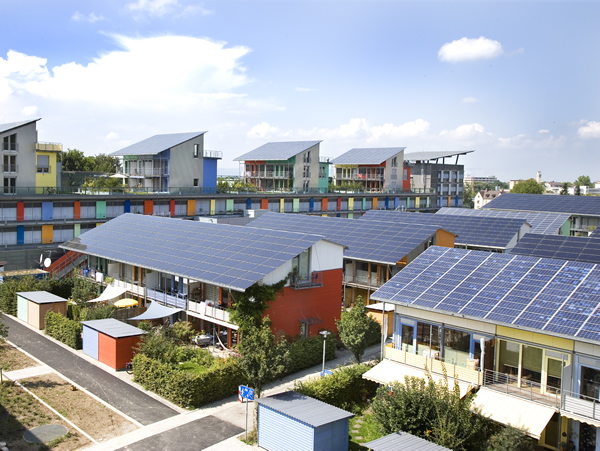
Photo by Andrew Glaser | Creative Commons
Just as there’s no such thing as a “one size fits all” microgrid design, there’s no “one-size-fits-all” microgrid control system. Controls are often described as the “brains” of the microgrid.
There’s wishful thinking that controls might eventually become as cheap and easy to implement as “plug and play” computer devices, but currently, in this rapidly emerging field, the only certainty about microgrid control systems is that it takes a lot of brains to design them.
Microgrid Control Systems: Basic Functions
Microgrid controllers need to coordinate the performance of multiple distributed energy resources (DER), managing their dispatch to provide stable power output and meet other goals specified by the user. In addition to minimizing costs, those goals could include providing reliable backup power in the case of a grid outage, or maximizing renewable energy use or carbon reduction. Control systems might also need to manage the microgrid in both grid-tied or islanded mode. Grid-tied microgrids need to synchronize with the main grid and safely manage switching between modes. An advanced, but important role of a controller is to also manage loads or integrate with a building automation system..
In a relatively simple solar+storage microgrid, the most important job of the control system might be to manage the use of solar energy during daylight hours and discharge batteries when the solar resource becomes unavailable. The control system for a grid-tied distributed energy system could also be set to discharge batteries to coincide with the onset of peak prices for grid power, or manage the peak facility demand, providing important cost savings for the user. When systems operate off-grid with solar and a generator, a controller is needed to curtail some of the solar when it would otherwise force the generator to run below its minimum load.
Sophisticated microgrid control systems have some important new challenges that aren’t typical of traditional energy management systems. They include managing bi-directional power flows, regulating loads (to prioritize critical loads for example), and ensuring that the different components of a microgrid communicate with each other and the central processor. Grid-tied control systems might also be enabled to respond to signals from a utility, making voltage and frequency adjustments to provide reserve capacity, balance power fluctuations, and buffer the intermittent nature of renewable generation.
Finally, the control system could be required to pull in data from the cloud such as weather forecasts, utility tariffs and energy prices in order to manage functions such as demand charge reduction, demand response, and market transactions.

U.S. Navy Photograph by Mass Communication Specialist 2nd Class Daniel Barker/Released
What’s In a Microgrid Control System?
The entire microgrid control system normally includes a combination of hardware and software components, including sensing equipment that monitors and controls the various energy resources such as solar PV arrays, inverters, batteries, diesel or natural gas powered generators, and utility interconnection meters. Networking and communications equipment and software together transmit signals between generation resources and the software that make up the “brains” of the controller, which runs on a dedicated computer. Then there’s a human machine interface, or program that allows users to manage the whole system from some type of user interface or dashboard. Finally, as we noted above, there might be an integration with cloud-based data resources that provide critical decision support for the microgrid on future weather patterns or energy pricing.
Choosing Control Systems
Ultimately, all microgrid control system capabilities must work together to meet specific performance objectives, helping a given microgrid fulfill the purposes for which it was designed, whether that be resiliency, carbon reduction, savings on electricity costs, or the provision of ancillary services for a utility. In each case, the control system has to be configured and managed to meet those particular goals.
Modeling Dispatch Using the HOMER Software: Anticipating Control System Performance
One way to explore control system performance is with the HOMER Energy modeling software products HOMER® Pro and HOMER Grid. These programs use various dispatch algorithms to help users understand the role and objectives of control systems in their microgrid and DER designs. The programs model the contributions of different distributed energy resources over a project lifetime, so users can test the outcomes of their dispatch strategy and how it impacts system design, emissions, ROI, and other metrics. HOMER users can view graphs that compare dispatch algorithms. HOMER Pro users can create their own control strategies in MATLAB and run them in HOMER Pro, allowing them to see how a custom dispatch strategy would function in their microgrid system, and what the financial implications would be.
 Developing Affordable Control Systems
Developing Affordable Control Systems
According to Mike Murray, co-founder of Ageto Energy and maker of the Ageto Renewable Controller (ARC), “the control system for a complex microgrid can present serious challenges for project developers who need to select, purchase, install and configure it. Given the wide range of available controllers, it’s hard to make an informed decision.” The complexity arises from the number of tasks the controller is expected to perform, which in turn affects the number of components and their sophistication. Murray points out that basic, primary control mechanisms are already incorporated in individual inverters, generators, and battery systems. But those control mechanisms don’t enable control of the microgrid as a whole.
HOMER International Microgrid Conference Will Feature Controls Track
The wide diversity of control systems and their increasing importance in the performance of advanced microgrids is one reason we decided to include an education track on microgrid controls at this year’s 6th Annual HOMER International Microgrid Conference. Along with Ageto Energy, we’ll hear from NEC Energy Solutions presenting on open source controls, and Trimark, which aims to reduce the cost of controls for small microgrids by 75%.
The presentations on controls will include:
“Off-Grid Microgrid Case Study Using HOMER to Seal the Deal,” Mike Murray, Ageto Energy
“A Smart and Flexible Microgrid with a Low-cost Scalable Open-source Controller and Pre-packaged Energy Storage,” Philip Fischer, NEC Energy Solutions
“Planning for Failure – What Do You Do When Your Microgrid Controller Fails?” by Scott Barrington, Trimark Associates, Inc.
You can learn more about the conference agenda here.
Register now for the HOMER International Microgrid Conference. It’s not too late!

That’s a very informative piece on the subject. We have developed an algorithm for maximizing use of renewable energy in a microgrid and trying to implement on hardware (micro-controllers). Any suggestions are welcome.
Have you tried using the MATLAB link to model your controller in HOMER Pro? That might be a way to help demonstrate it virtually.